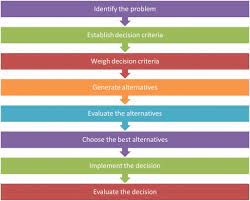The Rational Decision Making Process
Decision making is a crucial aspect of our daily lives, and understanding the rational decision making process can help us make better choices. The rational decision making process is a systematic, step-by-step approach to decision making that involves evaluating all possible options and selecting the best one based on careful analysis and reasoning.
The rational decision making process typically involves the following steps:
- Identifying the Problem: The first step in the process is to clearly define and understand the problem or decision that needs to be made.
- Gathering Information: Once the problem is identified, gather relevant information and data that will help in evaluating different options.
- Identifying Alternatives: Generate a list of possible solutions or alternatives to address the problem.
- Evaluating Alternatives: Assess each alternative based on criteria such as feasibility, cost, risks, and potential outcomes.
- Making a Decision: Select the best alternative based on the evaluation of each option. This step may involve weighing the pros and cons of each alternative.
- Implementing the Decision: Put the chosen solution into action and monitor its progress to ensure it is effective.
- Evaluating the Decision: After implementing the decision, evaluate its success and effectiveness. Reflect on what worked well and what could be improved for future decisions.
The rational decision making process provides a structured framework for making informed decisions by considering all available information and alternatives. While it may not always be possible to follow this process perfectly in every situation, understanding its principles can help individuals make more logical and effective decisions in both personal and professional settings.
By utilizing rational decision making techniques, individuals can enhance their problem-solving skills, minimize risks, and increase their chances of achieving positive outcomes in various aspects of life.
Five Key Advantages of a Rational Decision-Making Approach
- Facilitates logical and systematic approach to decision making.
- Helps in evaluating all possible options before making a choice.
- Encourages consideration of relevant information and data for informed decisions.
- Minimizes the impact of emotions on decision making process.
- Increases the likelihood of selecting the best alternative based on careful analysis.
Five Drawbacks of the Rational Decision-Making Process: Time Constraints, Analysis Paralysis, Disregarding Gut Feelings, Information Limitations, and Neglect of Emotions
- 1. Time-consuming
- 2. Over-analysis
- 3. Ignoring intuition
- 4. Limited by available information
- 5. Emotional factors overlooked
Facilitates logical and systematic approach to decision making.
One of the key advantages of the rational decision making process is that it facilitates a logical and systematic approach to decision making. By following a structured framework that involves identifying the problem, gathering information, evaluating alternatives, and making a decision based on careful analysis, individuals can ensure that their decisions are well-thought-out and based on rational reasoning. This methodical approach helps in minimizing impulsive decisions and allows for a thorough consideration of all available options, ultimately leading to more informed and effective decision-making outcomes.
Helps in evaluating all possible options before making a choice.
One of the key advantages of the rational decision-making process is its ability to help individuals evaluate all possible options thoroughly before making a choice. By systematically considering and analyzing each alternative, individuals can make more informed decisions that are based on a comprehensive understanding of the available choices. This approach allows for a more thoughtful and deliberate decision-making process, leading to better outcomes and reducing the likelihood of making impulsive or uninformed choices. Ultimately, by evaluating all possible options, individuals can increase the likelihood of selecting the most suitable solution for their specific needs or circumstances.
Encourages consideration of relevant information and data for informed decisions.
One of the key advantages of the rational decision making process is that it encourages the consideration of relevant information and data to make informed decisions. By systematically gathering and analyzing pertinent data, individuals are better equipped to evaluate different options and select the most appropriate course of action. This approach helps in minimizing bias and subjectivity, leading to decisions that are based on facts and evidence rather than solely on intuition or emotion. Ultimately, by prioritizing the use of relevant information, the rational decision making process promotes sound judgment and increases the likelihood of achieving successful outcomes.
Minimizes the impact of emotions on decision making process.
One significant advantage of the rational decision making process is its ability to minimize the impact of emotions on the decision-making process. By following a systematic approach that focuses on gathering and analyzing relevant information, individuals can make decisions based on logic and reason rather than being swayed by their emotions. This helps in ensuring that decisions are made objectively, leading to more thoughtful and well-informed choices that are less likely to be influenced by temporary feelings or biases.
Increases the likelihood of selecting the best alternative based on careful analysis.
One of the key benefits of the rational decision making process is that it increases the likelihood of selecting the best alternative through careful analysis. By systematically evaluating all available options, considering relevant information, and weighing the pros and cons of each alternative, individuals can make more informed decisions that are based on logic and reasoning. This methodical approach helps to minimize biases and emotional influences, leading to a more objective assessment of choices and ultimately increasing the chances of choosing the most optimal solution for a given problem or situation.
1. Time-consuming
One significant drawback of the rational decision making process is its time-consuming nature. The thorough evaluation and analysis required for each available alternative can consume a considerable amount of time, leading to delays in decision-making. Gathering and meticulously examining information for all potential options can be a laborious task, especially in complex or high-stakes situations. This extended time commitment may not always be feasible or practical, particularly in fast-paced environments where quick decisions are necessary. As a result, the time-intensive nature of the rational decision making process can sometimes hinder timely and efficient decision-making processes.
2. Over-analysis
One significant drawback of the rational decision-making process is the potential for over-analysis. When individuals spend too much time scrutinizing and evaluating each option, they may fall into a trap of indecision or decision paralysis. Over-analyzing can result in delays in making a choice, which can be detrimental, especially in time-sensitive situations where prompt decision-making is crucial. This con highlights the importance of finding a balance between thorough analysis and timely action to avoid getting stuck in a cycle of endless deliberation without reaching a resolution.
3. Ignoring intuition
One significant drawback of the rational decision-making process is the tendency to ignore intuition. By placing exclusive emphasis on logic and reason, individuals may disregard valuable insights that can be derived from intuition or gut feelings. Intuition, often based on subconscious processing of information and past experiences, can provide unique perspectives and prompt innovative solutions that rational analysis alone may overlook. Failing to consider intuition in decision-making may limit the depth of understanding and potentially hinder the discovery of more creative and effective choices.
4. Limited by available information
One significant drawback of the rational decision-making process is being limited by available information. In certain situations, there may be a lack of sufficient and reliable data to make a fully informed decision. This limitation can hinder the effectiveness of the decision-making process, as incomplete information may lead to uncertainty and potential errors in judgment. Without access to comprehensive data, individuals may struggle to evaluate alternatives accurately and may end up making suboptimal decisions based on incomplete or biased information. This con highlights the importance of recognizing the constraints of available information and finding ways to mitigate this limitation through additional research, analysis, or seeking expert advice.
5. Emotional factors overlooked
One significant drawback of the rational decision-making process is that it often overlooks emotional factors. By placing a strong emphasis on logic and factual analysis, this approach may fail to fully consider the emotional nuances that can greatly influence decision outcomes. Emotions play a crucial role in shaping our perceptions, preferences, and behaviors, and neglecting them in the decision-making process can lead to suboptimal choices. It is important to recognize that emotions can provide valuable insights and perspectives that should be taken into account alongside logical reasoning for a more holistic and well-rounded decision-making approach.




